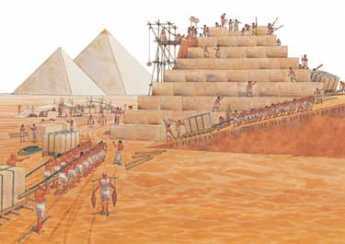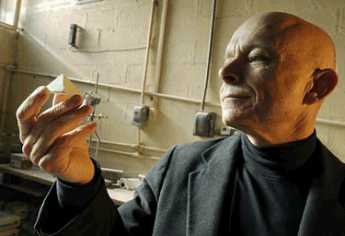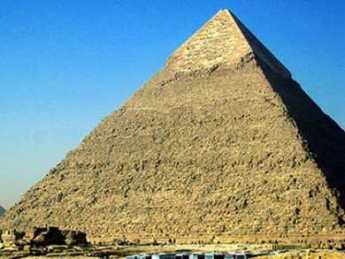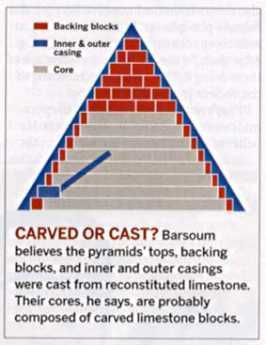Related Topics
Academia in the Philadelphia Region
Higher education is a source of pride, progress, and aggravation.
Science
Science
Architecture in Philadelphia
Originating in a limitless forest, wooden structures became a "Red City" of brick after a few fires. Then a succession of gifted architects shaped the city as Greek Revival, then French. Modern architecture now responds as much to population sociology as artistic genius. Take a look at the current "green building" movement.

Right Angle Club 2009
The 2009 proceedings of the Right Angle Club of Philadelphia, beginning with the farewell address of the outgoing president, John W. Nixon, and sadly concluding with memorials to two departed members, Fred Etherington and Harry Bishop.
Pyramid-Building, Greatly Simplified

|
| Egyptian pyramids were supposed to be built |
Everyone who went to Sunday School knows the Egyptian pyramids were supposed to be built by huge numbers of slaves, quarrying stone blocks, transporting them with only crude rollers, and setting them precisely in place under the supervision of slave-drivers with whips. The number of stones has been estimated, a reasonable time estimate made for carving a block, and modern scholars have calculated that every single person in Eqypt must have been either a slave or a slave-driver. In fact, there is a theory among British scholars that such a mobilization of the entire nation could only have been motivated by religious fanaticism, since it's so hard to imagine keeping a nation at work involuntarily in the hot sun for twenty or more years, even with whips.

|
| Michael Barsoum |
As recently described to the Right Angle Club by Professor Michael Barsoum of the Ceramics Department of Drexel University, we probably have to revise our views. A "Eureka" moment seems to have first arrived for a French Professor named Joseph Davidovits several years ago, with the thought that perhaps the building blocks of the pyramids may have been cast in place rather than carved. Poured concrete, so to speak, rather than carved out of a quarry and pushed over the desert in some fashion and hauled up into place. Since the blocks seem precisely chiseled to fit together exactly, it has always been hard to imagine how this was done, when the Egyptians were thought to have no iron tools, only pure copper as a metal ingredient, not even bronze.

|
| Khufu Pyramid |
The insight was brilliant, although the evidence for it was weak, and it has been pretty easy to pick holes in the proposal. Poured concrete is much easier to reconcile with the remarkable leveling of the stone blocks, where the bottom level of the Khufu pyramid is the size of eight football fields but only varies from true level by one inch overall. Exploratory cuts into the sides of the pyramids reveal the component stones to vary enormously in size and shape in the interior, although the exterior surface is quite smooth. Similarly, the lateral sides of the pyramids vary from true north by only 1/15 of a degree, a remarkable achievement for stone cutting with primitive tools. Broad Street in Philadelphia supposedly runs North and South, for example, but it deviates from true north by six degrees. The pyramid builders, like the architects of ancient Beijing, must have used the Pole Star for orientation, rather than a magnetic compass.

|
| Carved or Cast |
While Davidovits got this line of thinking started, Michael Barsoum has considerably advanced the proof of idea by addressing a large number of nitty-gritty questions about just how all this might have been accomplished. For example, the science of ceramics shifted the idea from the Portland Cement model to a recognition that the calcium in the cement came probably from diatomaceous earth, which is to say the crushed skeletons of diatoms on the ocean floor. Microscopic examination of the cement reveals large numbers of intact diatoms, with the cement layer surrounding the limestone aggregates. Furthermore, analysis of the stones shows that the outer shell of the pyramid was cast concrete, but the interior main mass was composed of stone rubble of various sizes and shapes. The apex of the pyramid was pure casting, probably because of the difficulty of fitting exterior and interior stones at the point. So, the Drexel team carried Davidiovits' idea from a general concept to a practical description of how the construction was probably accomplished. Carbon dating was attempted, but this technique stops being accurate for such remote time periods.
To nail down the idea that Philadelphia really explained how to build pyramids, funds are being collected for the construction of a 27-foot model pyramid in Logan Square. Let's hope the community gets behind this effort, which is both scholarly and entertaining, with an element of international competition mixed in. After all, Philadelphia is still smarting from the erection of the Eiffel Tower, six feet higher than Philadelphia City Hall, as the tallest structure in the world at that time. Let's be clear about it: the Eiffel Tower was the tallest structure in the world, while our City Hall remained the tallest building.
Originally published: Tuesday, October 27, 2009; most-recently modified: Monday, June 03, 2019